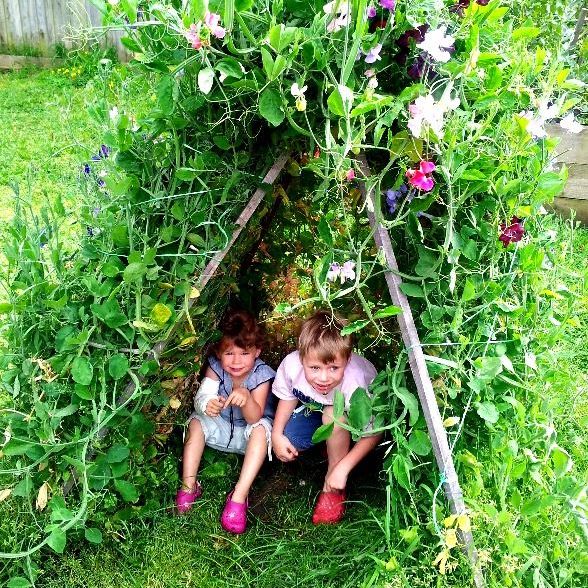In recent years, there has been a growing disconnect between children and their food. Most kids have never set foot on a farm or in an orchard, only ever seeing food go from the grocery store to their house to their plate. Thousands of children have never before witnessed the food they eat actually growing in the ground.
What better way to introduce this concept, and foster an appreciation for the food they eat, then integrating it into their play?
Benefits of gardening with your kids
Gardening with children has so many benefits to their physical and mental health:
Body control and development: There is a lot of physical activity involved with gardening, such as carrying tools, digging, planting, and more. This helps children develop their body management and locomotor skills. There is also quite a bit of precision involved with gardening, which helps children master their fine motor skills.
Sensory development: Working in a garden exposes children to a huge range of sounds, smells, sights, and textures. The cold water from the hose, the smell and feel of the soil, the clinking sound of shovels and trowels – all of these stimulate the senses and allow children to experiment with those.
Language and literacy: There are so many terms and words to be learned while gardening. Younger children can learn to form words and express themselves, older children can learn reading skills and new vocabulary.
Plant and food knowledge: Growing their own garden teaches kids how to identify, grow, and take care of plants. It also vastly increases their awareness of how their food is made from the soil to their plate.
Mental health: Spending time outside gardening and in nature is good for everyone’s mental health, children included! It can be meditative and stress relieving. It provides interactive time for parents and their children to spend together, which improves both party’s mental and emotional wellbeing and connects you as a family.
Makes your kids want to eat more veggies: Studies have shown that the more kids are involved with food preparation, in particular the growing of those foods, the more vegetables and fruits they will eat. Growing their own garden makes them more willing and actually excited about trying new foods. If your kids are involved in the process of making the food all the way from the garden to the kitchen table, they are much more likely to eat their dinner.
Growing a living playhouse
Living playhouses are the perfect way for your children to be a part of the process of growing fruits and vegetables from a seed to full ripeness in a way that also provides them with a natural, calm place to play. Living playhouses are also relatively simple, leaving room for your kid’s imagination to run wild.
How to make a living playhouse
There are so many different types of fruits and vegetables that grow best up a trellis or fence. This gives you a large variety to choose from when selecting which plants you want for your child’s playhouse.
- Cucumbers
- Squash
- Pole beans
- Tomatoes
- Sweet potatoes
- Sweet peas
Choosing your vegetable depends largely on what type of soil you have and what size and shape your base structure will be.
Other items you will need:
- Bamboo canes (8-10, 6 or 7 feet-long)
- 1 packet of seeds (or more, depending on which vegetable you choose)
- Gardening string
- Chicken wire (optional)
Once you have gathered your items, follow these simple steps to build your living playhouse:
- Choose your plot of land. This can be a spare spot in your garden or somewhere on the lawn in your back yard.
- Put your bamboo into the ground. Push the shoots firmly into the ground evenly-spaced apart in the shape that you want them. Make sure that you leave a wider space in the front for an entrance.
- Create your garden. At the base of each cane, dig up an area that is 12″ wide, 12″ long and 12″ deep at minimum. You can also dig a continuous 12″-wide bed in a ring surrounding the entire perimeter of the bamboo canes. Be sure to mix in some compost or manure into your soil to provide much-needed nutrients for your veggies.
- Plant your seeds. Poke two 1”-2” holes at the base of each bamboo cane. Drop one seeds into each hole and fill it with water. Once the water has soaked into the soil, gently cover the holes with soil and water again. You may also want to start them in pots and then transplant them once they are already 6-inches in height.
- Protect your plants. Consider using organic methods of controlling slugs. You may need to help some of your vines reach the bamboo if they don’t do so on their own. Take those tendrils and gently wrap them around the bamboo. Cover the base of the plants with wood chips or lawn clippings to help keep the moisture in, and be sure to water them often, especially in hot, dry periods.
If you are growing beans or peas, make sure you are picking them regularly (once they are ripe) so that the plants continue to flower and produce vegetables.
This is a fun project you can do with your kids, so get them involved as much as possible! The more they help out with, the more learning, fun, and pride they will have in the playhouse.
Happy gardening!








